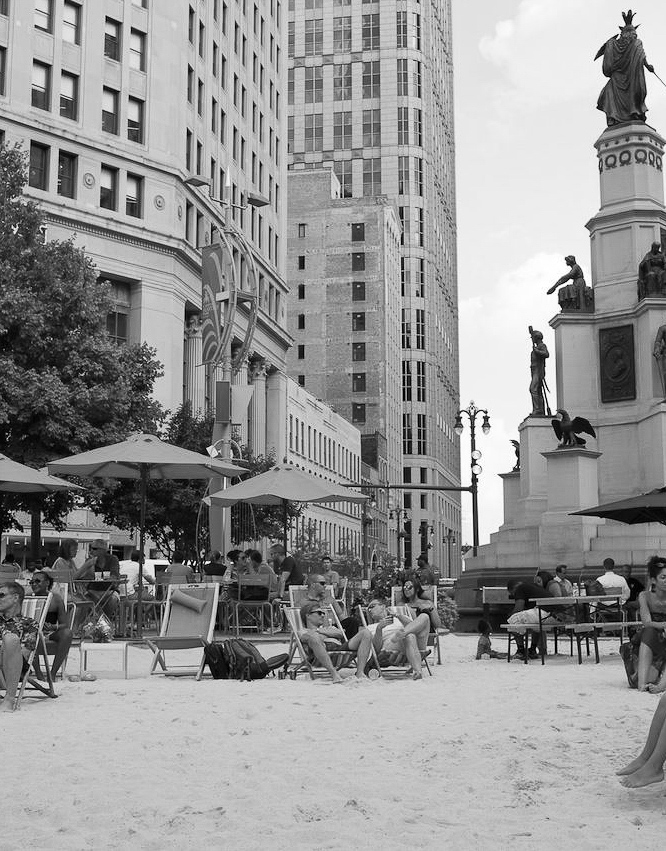6.3. Movable Seating
Aus Pattern Language Wiki
Along the Walkable Streetscape, provide places for people to sit and relax comfortably.
Problem-statement: Along streets and in other public spaces, people need to do more than walk — they need to sit too. And they need to be able to change the position of their seating depending on their activity.
Discussion: Sometimes people are comfortable in public spaces with rigid benches that face in only one direction. Many times, however, they want to turn toward their companions, or toward interesting things happening within the public realm. For this reason, they need movable seating. This need is greatest at the edges of public space, where people are most likely to congregate and view others.¹
This feature poses a problem for security, since the seats can potentially be stolen. There are two remedies for this problem: either tether the seats to secure cables, or provide seating via adjacent private businesses, who can remove and store them at closing time.
This pattern, which may appear trivial, in fact goes to the heart of adaptive design philosophy and practice. The shaping of space and the positioning of built components are influenced by an enormous number of subtle factors, often perceivable only on the actual site. These may include: direction of sunlight; prevailing wind; shadows from adjoining buildings; psychological effects from nearby traffic; very fine adjustments to adjust to existing pedestrian flows; and so on. For this reason, the odds of getting the placement of fixed public seating exactly right by fitting them through premeditated design are infinitesimally small. Moreover, since conditions change all the time, an accidentally correct permanent placement will not continue to be valid in the future. On the other hand, having movable seats lets the users make the adjustments themselves. There is also the psychological feeling of control and ownership if a user can move a chair, even slightly. This freedom allows people to enjoy a public space.
Therefore:
Provide ample seating within the walkable public realm, especially at the edges. Make sure that at least some of the seating is movable, so that people can adjust their position for comfort.
Provide Human-Scale Detail adjacent to the seating. Give the chairs Handles and Friendly Surfaces. …
¹ A classic study on movable chairs was done by William H. Whyte in his 1980 New York public space study. See Whyte, W. H. (1980). The Social Life of Small Urban Spaces. New York: Project for Public Spaces.
Mehaffy, M. et al. (2020). MOVABLE SEATING (pattern). In A New Pattern Language for Growing Regions. The Dalles: Sustasis Press. Available at https://pattern-language.wiki/.../Movable_Seating
SECTION I:
PATTERNS OF SCALE
1. REGIONAL PATTERNS
Define the large-scale spatial organization…
1.4. 400M THROUGH STREET NETWORK
2. URBAN PATTERNS
Establish essential urban characteristics…
3. STREET PATTERNS
Identify and allocate street types…
4. NEIGHBORHOOD PATTERNS
Define neighborhood-scale elements…
5. SPECIAL USE PATTERNS
Integrate unique urban elements with care…
6. PUBLIC SPACE PATTERNS
Establish the character of the crucial public realm…
7. BLOCK AND PLOT PATTERNS
Lay out the detailed structure of property lines…
8. STREETSCAPE PATTERNS
Configure the street as a welcoming place…
9. BUILDING PATTERNS
Lay out appropriate urban buildings…
10. BUILDING EDGE PATTERNS
Create interior and exterior connectivity…
10.1. INDOOR-OUTDOOR AMBIGUITY
SECTION II:
PATTERNS OF MULTIPLE SCALE
11. GEOMETRIC PATTERNS
Build in coherent geometries at all scales…
11.2. SMALL GROUPS OF ELEMENTS
12. AFFORDANCE PATTERNS
Build in user capacity to shape the environment…
13. RETROFIT PATTERNS
Revitalize and improve existing urban assets …
14. INFORMAL GROWTH PATTERNS
Accommodate “bottom-up” urban growth…
15. CONSTRUCTION PATTERNS
Use the building process to enrich the result…
SECTION III:
PATTERNS OF PROCESS
16. IMPLEMENTATION TOOL PATTERNS
Use tools to achieve successful results…
16.2. ENTITLEMENT STREAMLINING
16.3. NEIGHBORHOOD PLANNING CENTER
17. PROJECT ECONOMICS PATTERNS
Create flows of money that support urban quality…
17.4. ECONOMIES OF PLACE AND DIFFERENTIATION
18. PLACE GOVERNANCE PATTERNS
Processes for making and managing places…
18.3. PUBLIC-PRIVATE PLACE MANAGEMENT
19. AFFORDABILITY PATTERNS
Build in affordability for all incomes…
19.1. INTEGRATED AFFORDABILITY
20. NEW TECHNOLOGY PATTERNS
Integrate new systems without damaging old ones…
20.2. RESPONSIVE TRANSPORTATION NETWORK COMPANY


